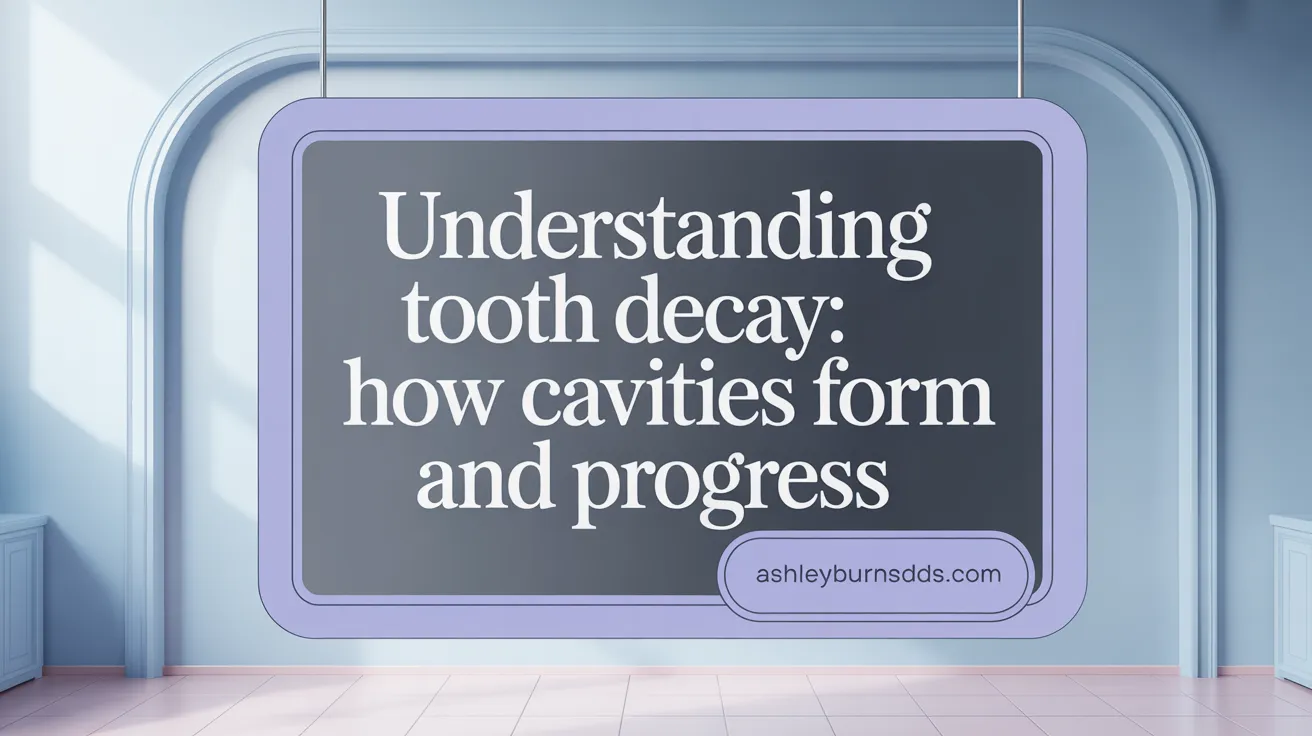Understanding Cavities: The Basics
Cavities, medically termed dental caries, are among the most common oral health issues worldwide, affecting people of all ages. Despite their prevalence, many people are unaware of what cavities truly are, how they develop, and how to recognize the earliest signs before they cause pain or irreversible damage. This article delves into the nature of cavities, identifying early warning signs, and highlights the importance of prevention and professional dental care in maintaining a healthy smile.
What Is a Cavity and How Does It Develop?

Definition of a cavity
A cavity, also called dental caries or tooth decay, is a small hole that forms in a tooth due to the destruction of its outer layer, the enamel. It results from the persistent activity of bacteria that produce acids which erode this protective layer.
Development process of cavities
The process begins when bacteria in the mouth feed on sugars and starches from food and drinks, especially if oral hygiene is poor. These bacteria form a sticky film called plaque on the teeth. As the bacteria metabolize the sugars, they produce acids that attack the enamel.
Role of bacteria and acids
The acids created by bacteria weaken the enamel by dissolving its mineral content. Over time, this demineralization creates tiny openings or white spots on the enamel surface, which can potentially be reversed with fluoride if detected early.
Plaque formation
Plaque is a buildup of bacteria, food particles, and saliva that forms rapidly after eating. If not regularly removed by brushing and flossing, plaque hardens into tartar, continuing to harbor bacteria and acids that accelerate decay.
Progression from enamel erosion to pulp infection
If the early demineralization is ignored, the acid and bacteria can penetrate deeper layers of the tooth—dentin and eventually reach the pulp chamber, where nerves and blood vessels are located. This progression can cause sensitivity, sharp pain, and even infections or abscesses, leading to more invasive treatments such as fillings, root canals, or extractions.
| Stage | Signs and Changes | Potential Treatment | Location of Decay |
|---|---|---|---|
| Demineralization | White, chalky spots on enamel | Fluoride applications, remineralization | Surface of the enamel |
| Enamel decay | Visible pits or holes | Fillings | Enamel |
| Dentin decay | Increased sensitivity, pain | Restorations, fillings | Inside the tooth beneath enamel |
| Pulp damage | Severe pain, infection, abscess | Root canal, extraction | Inner pulp tissue |
Understanding how cavities develop emphasizes the importance of good oral hygiene, regular dental checkups, and preventive measures like fluoride use and avoiding excess sugar intake to protect teeth from decay.
Recognizing the Early Warning Signs and Visual Indicators of Cavities

What are the early warning signs and symptoms of cavities?
Early warning signs of cavities include tooth sensitivity to hot, cold, or sweet foods and drinks. You might notice a dull ache or mild discomfort when eating or biting. Another sign is visible discoloration, such as white, brown, or black spots appearing on the teeth. Small pits or holes may develop as decay worsens, often accompanied by erosion of the tooth surface. In some cases, cavities cause bad breath or an unpleasant taste. If untreated, these early signs can lead to sharper pain, swelling, and infections, making timely dental visits crucial.
How can you identify cavities through visual and physical indicators?
To spot cavities visually, look for holes, pits, or rough, chipped areas on the tooth surface. Discoloration is also a key sign—white chalky spots, darker brown, or black stains indicate enamel damage. Physically, you might experience tooth sensitivity or pain when biting or consuming temperature extremes or sugary substances. Persistent bad breath may signal bacterial activity in compromised areas. Early cavities often manifest as white spots due to demineralization, which may later turn darker or develop into visible holes. However, some hidden cavities occur in areas between teeth that are not visible without X-rays or a professional exam.
Why are regular dental X-rays important?
Dental X-rays are vital for detecting cavities that are concealed beneath the surface or between teeth. These images reveal early decay stages before symptoms are apparent, allowing for prompt intervention. Regular checkups with X-ray assessments help catch cavities early, minimizing damage, reducing treatment complexity, and preventing infections. This proactive approach is especially important for identifying decay in areas difficult to see or feel during self-examination.
More Information
For a comprehensive understanding of early cavity signs and proper diagnosis, search for "Early signs of tooth cavities and diagnosis". Regular dental visits, combined with good oral hygiene, can significantly reduce cavity risk and support overall oral health.
Causes, Risk Factors, and Stages of Cavity Development

What causes cavities and what are the risk factors for cavity formation?
Cavities develop primarily from the interaction between bacteria in dental plaque and sugars or starches from the foods we eat. These bacteria produce acids as they feed on these carbohydrates. The acid gradually erodes the outer enamel layer of teeth, creating tiny holes or cavities.
Over time, if this process continues without intervention, the decay can deepen, affecting the underlying dentin and even reaching the pulp inside the tooth. This can lead to pain, infections, and the formation of abscesses.
Several factors increase the risk of developing cavities. Poor oral hygiene allows plaque to accumulate and harden into tartar, which protects bacteria and promotes decay. Frequent snacking or sipping sugary or acidic drinks supplies the bacteria with a constant source of fuel for acid production.
Low exposure to fluoride — whether from drinking water, toothpaste, or treatments — weakens the enamel’s resistance to decay. Saliva plays a crucial role by neutralizing acids and providing minerals for enamel repair; thus, dry mouth reduces this protective mechanism.
Other risk factors include wearing braces, having existing dental restorations, older age with receding gums exposing roots, and certain medical conditions like dry mouth or medication side effects that decrease saliva flow. Children, teenagers, and older adults are particularly vulnerable.
Preventive measures focus on maintaining good oral hygiene—regular brushing with fluoride toothpaste, flossing, and professional cleanings. Dietary habits are also vital: limiting sugary and sticky foods reduces acid attacks. Sealants provide an added protective barrier on molars. Regular dental visits for early detection and fluoride treatments further reduce the risk.
What are the different stages of cavity development, from early signs to advanced decay?
Cavity formation is a progressive process that spans several stages. Initially, acids produced by bacteria demineralize the enamel, leading to tiny mineral loss zones known as white spots. These white spots are early signs of decay and are often reversible with fluoride treatments and improved oral hygiene.
As the decay continues, it results in the formation of small cavities—holes that can be seen on the surface of the tooth. At this stage, the enamel has been breached, and the decay may still be managed with minimally invasive treatments.
If untreated, bacteria and acids seep deeper, reaching the dentin layer beneath the enamel. This causes increased sensitivity and a faster rate of decay. The pulp tissue inside the tooth — containing nerves and blood vessels — can become inflamed, leading to pain and possible infection.
In severe cases, the infection can develop into an abscess, a pocket of pus that indicates serious bacterial invasion. At this stage, the tooth often requires extensive treatment, such as root canal therapy or extraction.
Early detection through dental checkups and X-rays plays a vital role in catching cavities before they become severe. Treatment options vary from fluoride applications in the initial stages to fillings, crowns, or root canals as decay progresses.
Preventing Cavities: Effective Oral Health Practices
Cavities are largely preventable through diligent oral hygiene and professional care. Regularly brushing teeth twice daily with fluoride toothpaste is one of the most effective measures. Proper technique involves using a soft-bristled toothbrush to thoroughly remove dental plaque and cavities, a sticky film of bacteria that produces acids damaging the enamel. Flossing daily is equally important, as it cleans between teeth and along the gumline, areas often missed by brushing.
Limiting intake of sugary and acidic foods and beverages significantly reduces the acid attacks that lead to enamel erosion. Drinking fluoridated water and using a straw can help minimize direct contact of sugars and acids with teeth, providing additional protection.
The use of fluoride treatments, whether through toothpaste, mouth rinses, or professional applications like varnishes, strengthens enamel and promotes remineralization, creating a protective barrier against decay. Dental sealants, especially on molars and premolars, offer a physical shield that prevents food particles and plaque from settling into grooves and pits. These methods are key cavity prevention methods.
Routine dental checkups are vital for early detection of potential issues and the application of preventive measures. Dentists can recommend sealants and fluoride varnishes tailored to individual risk. Maintaining good oral hygiene habits along with regular professional care can significantly decrease the risk of cavities and preserve long-term oral health.
For more tips on cavity prevention, searching for...
The Importance of Early Detection and Professional Dental Assessment
 Early detection of cavities is essential to prevent the progression of tooth decay into more serious and painful conditions. When cavities are caught early, often before symptoms like pain or visible signs develop, dental professionals can intervene with minimal invasive procedures such as fluoride treatments or sealants, preserving more of the natural tooth structure.
Early detection of cavities is essential to prevent the progression of tooth decay into more serious and painful conditions. When cavities are caught early, often before symptoms like pain or visible signs develop, dental professionals can intervene with minimal invasive procedures such as fluoride treatments or sealants, preserving more of the natural tooth structure.
Dental exams and X-rays are fundamental tools in early cavity detection. These technologies allow dentists to see signs of decay that are not yet visible or felt by the patient, such as white spots or slight discolorations in the enamel. Advanced diagnostic tools like fluorescence devices and digital radiography enhance the ability to identify early decay, enabling timely action.
Regular dental check-ups are vital for monitoring oral health and catching cavities at their initial stage. Early diagnosis means treatments are simpler, quicker, and less expensive, reducing the risk of complications like infections or tooth loss. Early intervention not only alleviates discomfort but also minimizes the need for extensive procedures, making dental care more effective and cost-efficient.
By understanding the importance of professional assessment and early detection, patients can better protect their oral health. Routine visits help maintain healthy teeth, prevent the development of severe cavities, and promote overall well-being, emphasizing that prevention and early action are always preferable to extensive restorative treatments.
Protecting Your Smile: Vigilance and Care
Cavities begin silently, often without noticeable symptoms, making awareness and early detection crucial. Understanding how cavities develop, recognizing subtle early signs, and maintaining rigorous oral hygiene can prevent decay from advancing into painful and costly problems. Regular professional dental assessments not only catch hidden decay but also provide tailored preventive care to safeguard your teeth. Embracing these practices preserves your natural smile, avoids invasive treatments, and promotes lifelong oral health.
